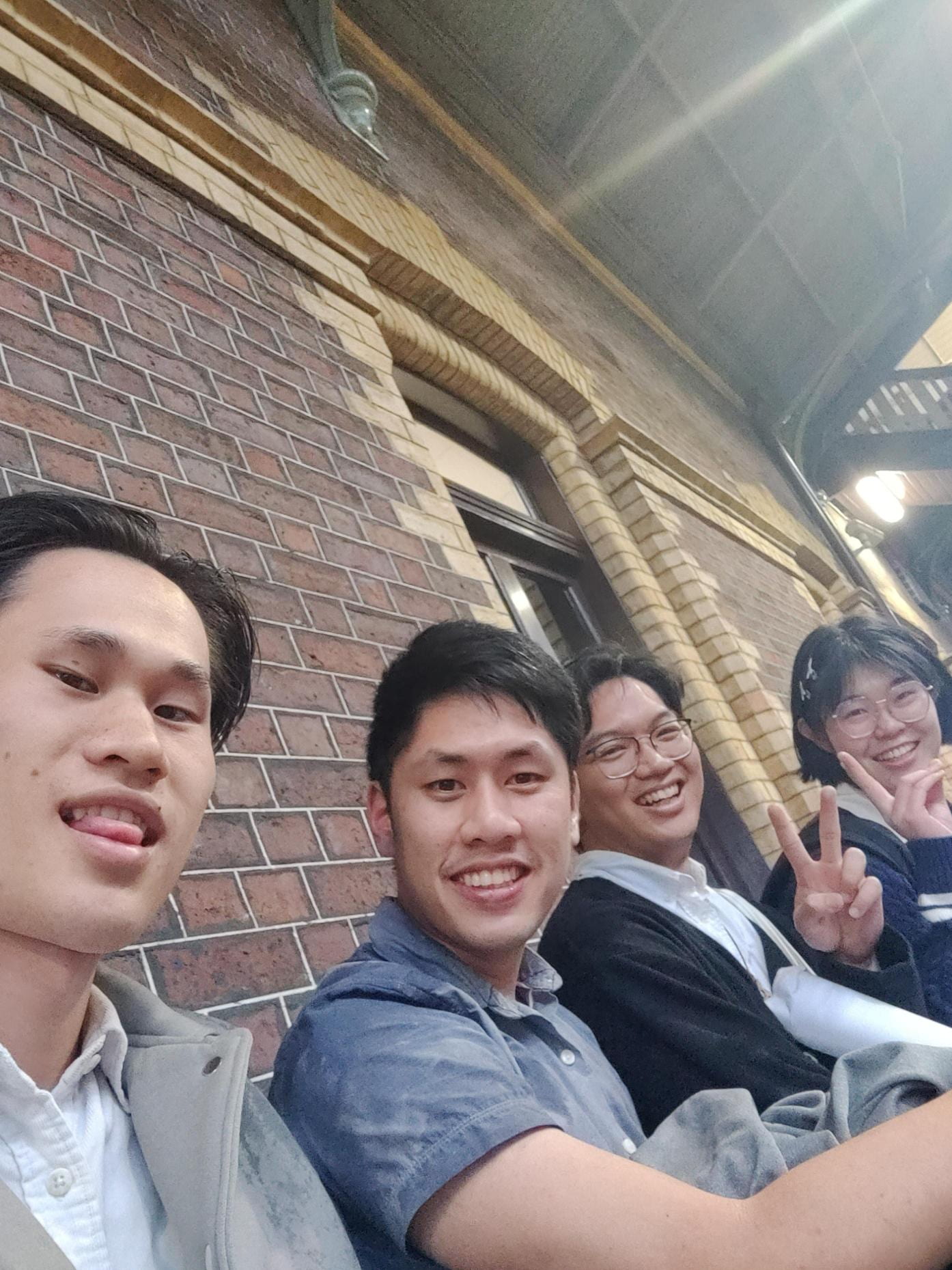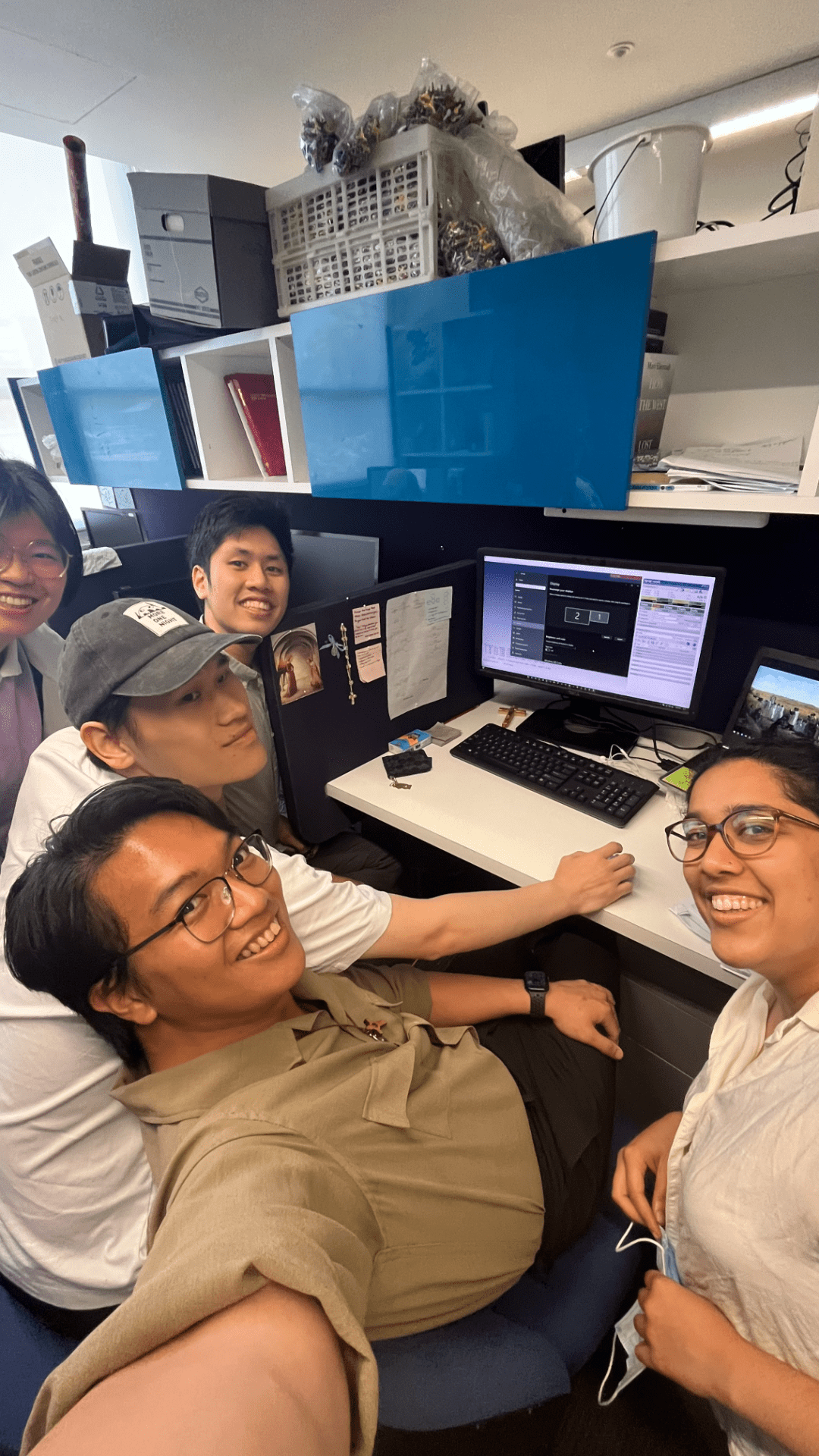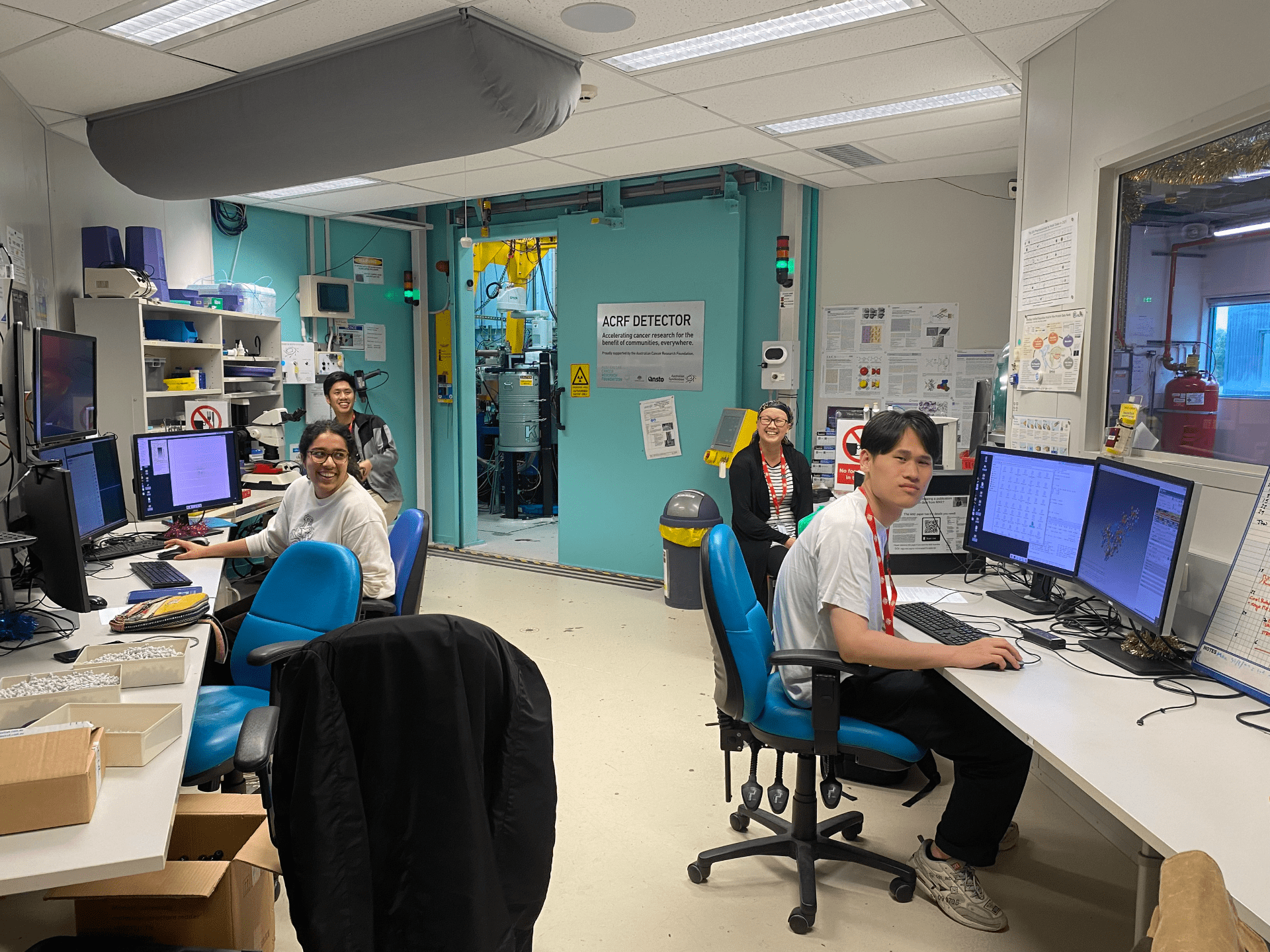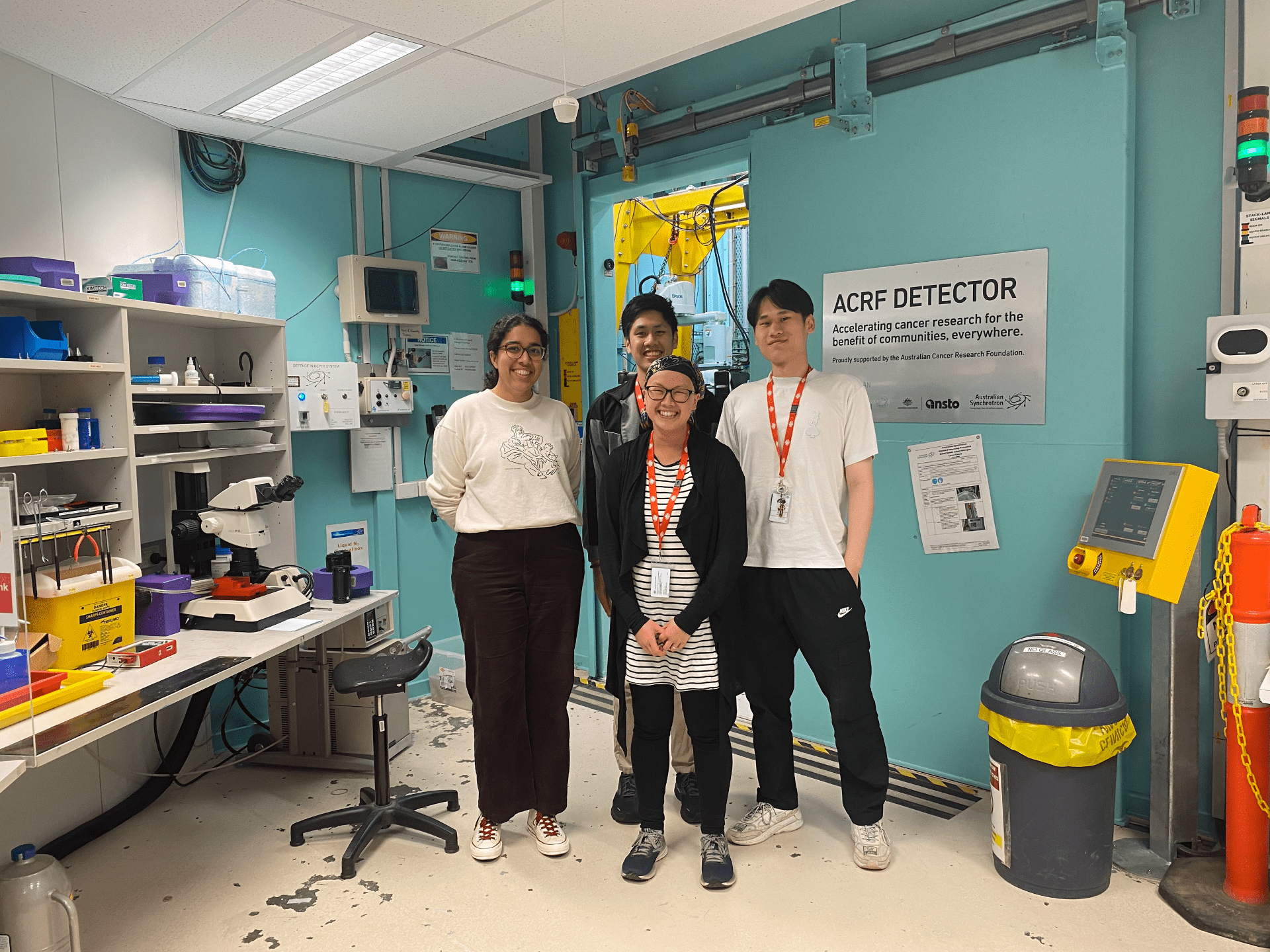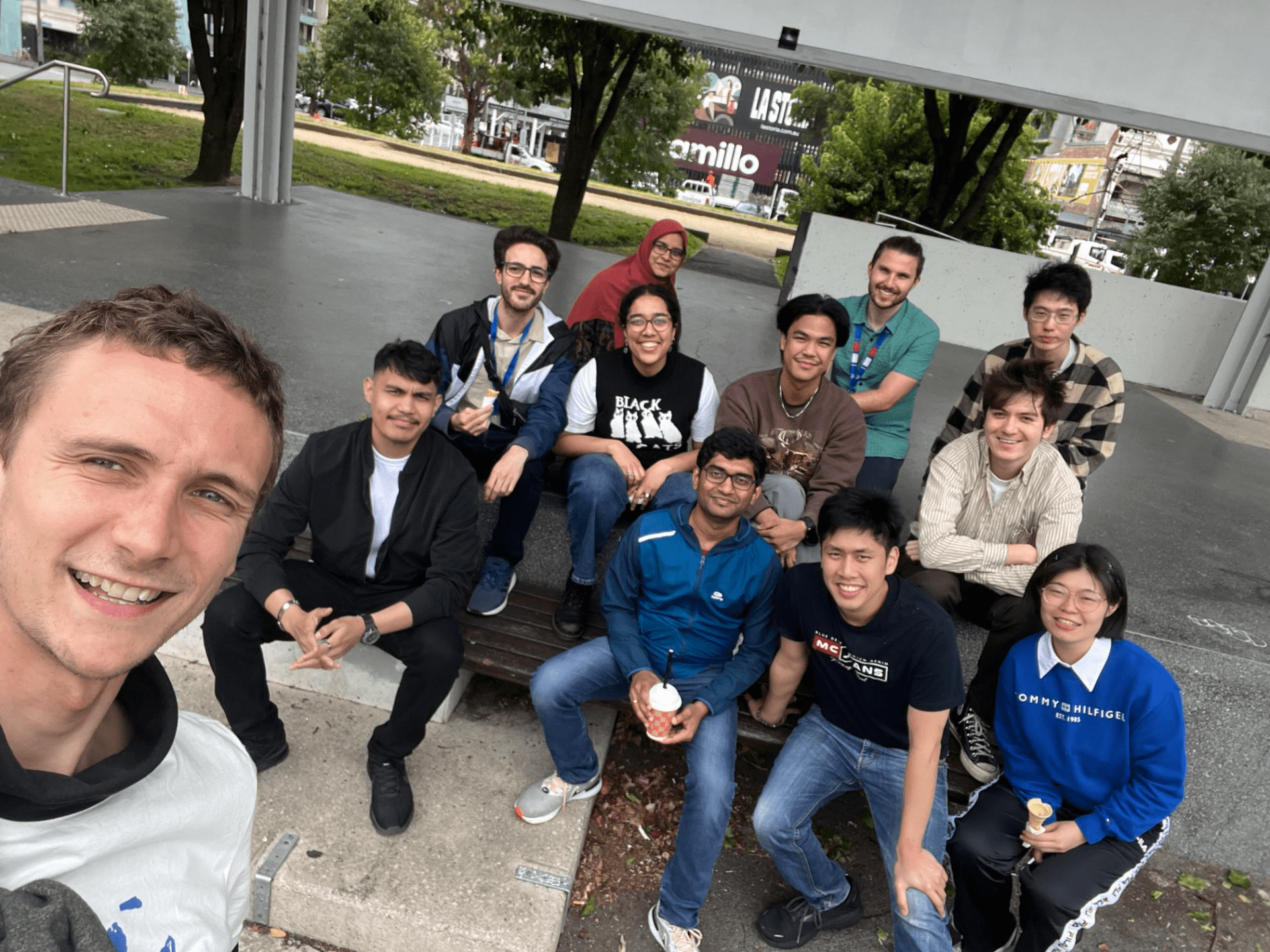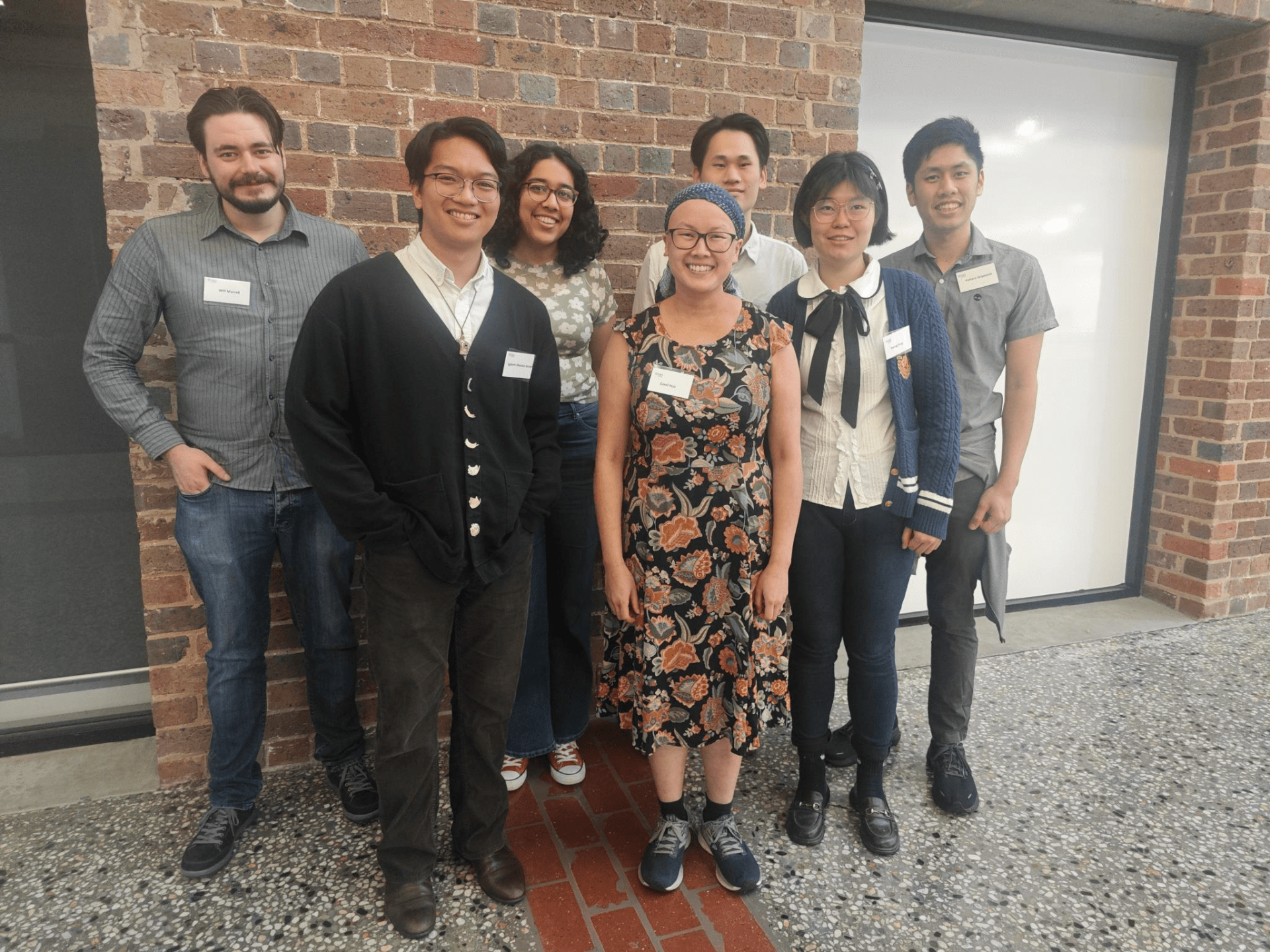Home page
Welcome!
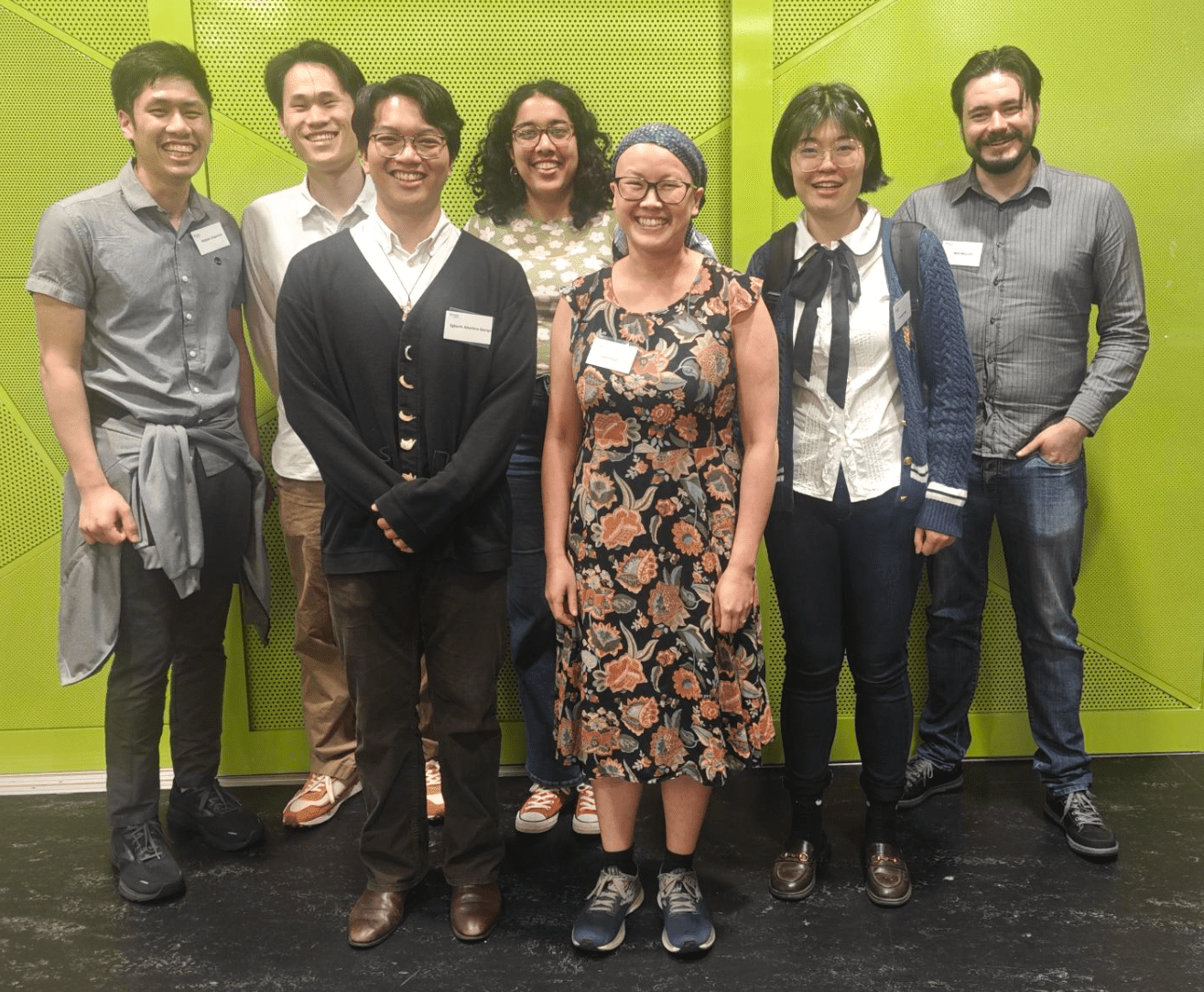
Welcome to the Hua research group page. We are based in the School of Chemistry at the University of Melbourne and have recently joined the ARC Centre of Excellence for Exciton Science. Our research involves using supramolecular inorganic chemistry to make materials for the next generation of technological devices and chemical sensors of importance for health and the environment. Specific areas of research include the development of stimuli responsive materials and chemical sensors for chiral molecules. Projects typically involve the synthesis of new MOFs and their analysis by x-ray crystallography. Additional characterisation techniques include solid and solution state NMR, fluorescence, thermal gravimetric analysis, electron paramagnetic resonance (EPR), electrochemistry, circular dichroism, molecular magnetism and spectroelectrochemical experiments. We regularly access the MX beamlines at the Australian Synchrotron.
People interested in Honours, Masters or PhD projects with the group should contact Carol directly by email (carol.hua@unimelb.edu.au).
Group Members
Group Leader – Dr Carol Hua

Current Group Members
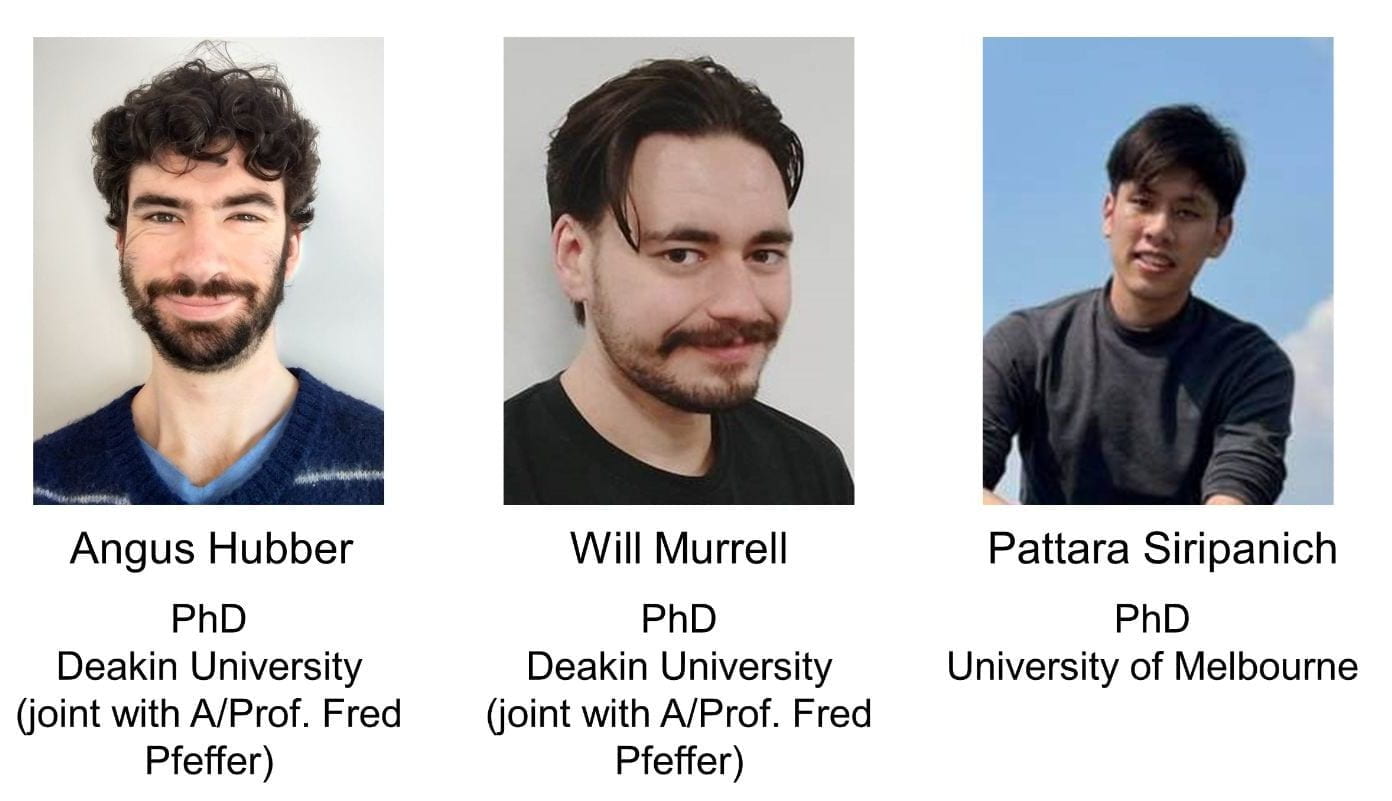
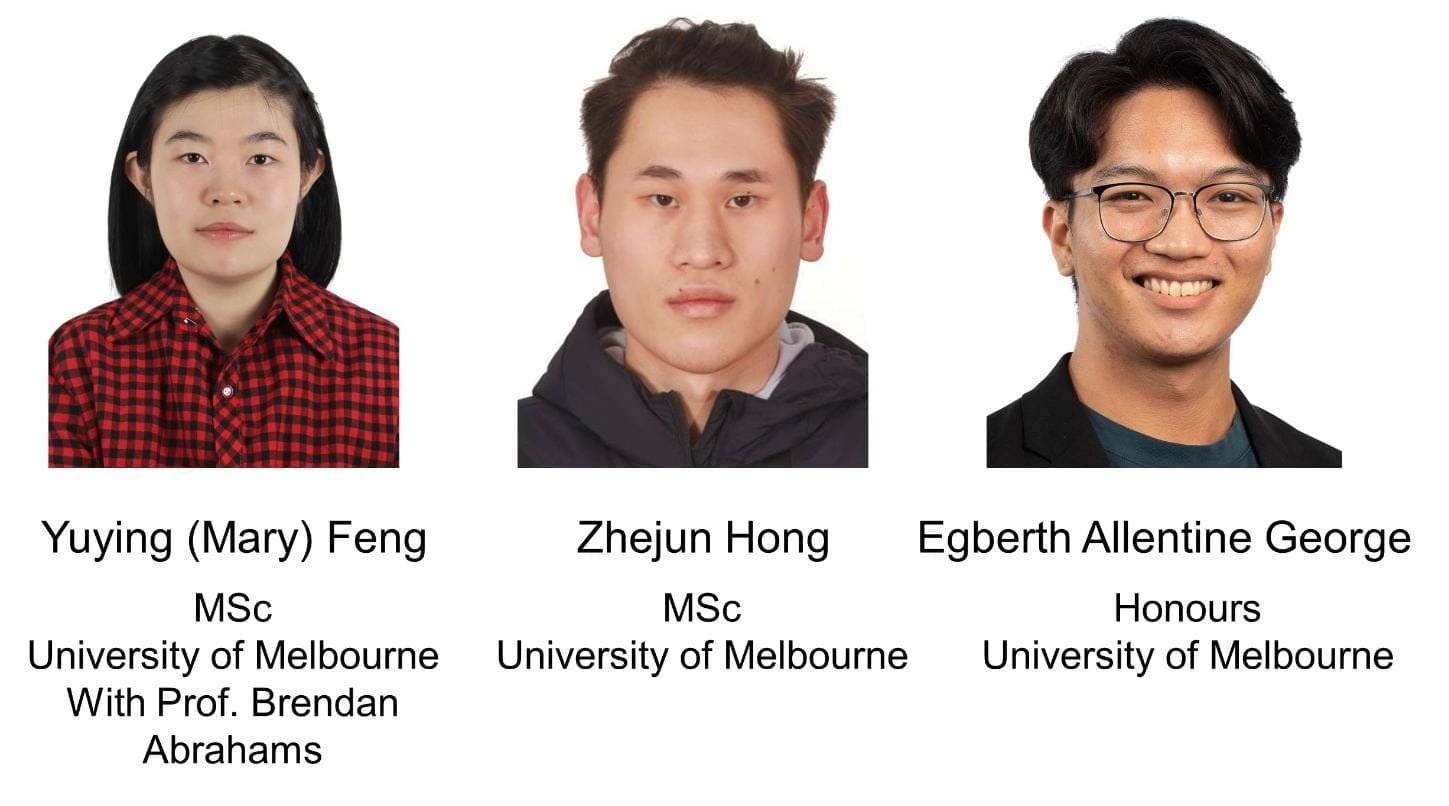

Undergraduate students
William Smith (Semester 1, 2024)
Group Alumni

Undergraduate students
Yuan Xu (Summer 2024)
Erisha Tayal (Summer 2023-2024)
Olivia Nania (Semester 2, 2023)
Moss Cowcher (Semester 2, 2023)
Emily Goddard (Semester 2, 2019)
Katya Bondaruk (Semester 2, 2018)
59. A. Hubber, C. Hua, “Chiral Metal-Organic Frameworks with Spectroscopic Methods: Towards Chemical Sensor Devices”, Chem. Eur. J., 2024, DOI: 10.1002/chem.202400071.
58. F. Rizzuto, S. C. Pal, E. Kearns, C. Hua, M. Solomon, T. Faust, C. J. Kepert, M. Das, D. M. D’Alessandro, “The Physical and Electronic Properties of Metal-Organic Frameworks Containing Dipyridylthiazolo[5,4-d]thiazole”, CrystEngComm, 2023, 25, 6434-6440.
57. C. Hua*, T. U. Connell*, “Controlling emission energy in metal organic frameworks featuring cyclometalated iridium(III) linkers”, Aust. J. Chem., 2023, 76, 686-695.
56. L. Tom, S. DiLuzio, C. Hua, T. U. Connell, “Understanding the role of cyclometalating ligand regiochemistry on the photophysics of charged heteroleptic iridium(III) complexes”, J. Coord. Chem., 2022, 11-14, 1722-1743.
55. M. Ahmed, K. A. Zenere, N. F. Sciortino, K. S. A. Arachchige, G. F. Turner, J. Cruddas, C. Hua, J. R. Price, C. J. Kepert, J. K. Clegg, F. J. Valverde-Munoz, J. A. Real, G. Chastanet, S. A. Moggach, B. J. Powell, S. M. Neville, “The regulation of multistep spin-crossover across multiple stimuli in a 2-D framework material”, Inorg. Chem., 2022, 61, 6641-6649.
54. H. M. Tay, E. J. Goddard, C, Hua, “Three-dimensional Cd(II) Porphyrin Metal-Organic Frameworks for the Colorimetric Sensing of Electron Donors”, CrystEngComm, 2022, 24, 7277-7282. Invited contribution for the New Talent 2022 Special Issue
53. S. Thoonen, H. M. Tay, C. Hua, “A chiral binaphthyl-based coordination polymer as an enantioselective fluorescence sensor”, Chem. Commun., 2022, 58, 4512 – 4515. Invited contribution for the ChemComm Emerging Investigators collection 2022
52. H. M. Tay, C. Hua, “A structural study into halogenated derivatives of mandelic acid as building blocks of chiral coordination polymers”, J. Coord. Chem., 2022, 11-14, 1656-1669. Invited contribution for the Emerging Leaders Special Issue
51. A. Bunyamin, C. Hua, A. Polyzos, D. Priebbenow, “Photochemical [2+1]-Cycloadditions of Nucleophilic Carbenes”, Chem. Sci., 2022, 13, 3273-3280.
50. H. M. Tay, C. Hua, “Chiral coordination polymers of mandelate and its derivatives: tuning crystal packing by modulation of hydrogen bonding”, Aust. J. Chem., 2022, 75, 94-101. Invited contribution for the Rising Stars in Chemistry special issue
49. M. van Koeverden, B. Abrahams, C. Hua, T. Hudson, R. Robson, “Inducing Structural Diversity in Anionic Metal-Tetraoxolene Coordination Polymers Using Templating Methyl Viologen Countercations”, Cryst. Growth Des., 2022, 22, 1319-1332.
48. M. B. Solomon, C. Hua, B. Chan, T. L. Church, S. M. Cohen, C. P. Kubiak, K. A. Jolliffe, D. M. D’Alessandro, “The Electrochemical Reduction of a Flexible Mn(II) Salen-Based Metal-Organic Framework”, Dalton Trans., 2021, 50, 12821-12825.
47. R. Elliott, A. Sutton, B. Abrahams, D. M. D’Alessandro, L. Goerigk, C. Hua, T. Hudson, R. Robson, K. White, “A Multifunctional Coordination Polymer Exhibiting Reversible Mechanical Motion Allowing Selective Uptake of Guests Leading to Enhanced Electrical Conductivity”, Inorg. Chem., 2021, 60, 13658–13668.
46. R. Sanii, E. Patyk-Kazmierczak, C. Hua, T. Pham, K. Forrest, B. Space, M. Zaworotko, “Towards an understanding of the propensity for crystalline hydrate formation by molecular compounds. Part 2”, Cryst. Growth Des., 2021, 21, 4927–4939.
45. D. Priebbenow, C. Hua, “Acyl Silanes as Weakly Coordinating Organosilicon Directing Groups in Cp*Rh(III)-Catalyzed Annulations”, Chem. Commun., 2021, 57, 7938-7941.
44. P. Doheny, C. Hua, B. Chan, F. Tuna, D. Collison, C. Kepert, D. M. D’Alessandro, “Substituent Effects on Through-Space Intervalence Charge Transfer in Cofacial Metal-Organic Frameworks”, Faraday Discuss., 2021, 231, 152-167.
43. S. Thoonen, C. Hua, “Chiral Sensing with Coordination Polymers”, Chem. Asian J., 2021, 16, 890-901. Invited contribution for the Early Career Special Collection.
42. X. Ong, M. Ahmed, L. Xu, A. Brennan, C. Hua, K. Zenere, Z. Xie, C. J. Kepert, B. J. Powell, S. M. Neville, “Spin-crossover 2-D Hofmann Frameworks Incorporating an Amide-functionalized Ligand: N-(pyridin-4-yl)benzamide”, Chemistry, 2021, 3, 360-372.
41. L. Ezzedinloo, K. Zenere, Z. Xie, M. Ahmed, S. Scottwell, M. Bhadbhade, H. Brand, J. Clegg, C. Hua, N. Sciortino, L. Parker, B. Powell, C. J. Kepert, S. Neville, “Hierarchical Spin Crossover Cooperativity in Hybrid 1-D Chains of FeII-1,2,4-trizole Trimers Linked by [Au(CN)2]– Bridges”, Chem. Eur. J, 2021, 27, 5136-5141.
40. H. M. Tay, N. Kyratzis, S. Thoonen, S. Boer, D. Turner*, C. Hua*, “Synthetic Strategies Towards Chiral Coordination Polymers”, Coord. Chem. Rev., 2021, 435, 213763, Invited contribution for the Supramolecular Aspects of Coordination Polymers issue.
39. M. Ahmed, Z. Xie, S. Thoonen, C. Hua, C. Kepert, J. Price, S. Neville, “A New Spin Crossover FeII coordination Environment in a Two-Fold Interpenetrated 3-D Hofmann-type Framework Material”, Chem. Commun., 2021, 57, 85-88.
38. H. M. Tay, A. Rawal, C. Hua, “S-Mg2(dobpdc): A metal-organic framework responsive to chirality in amino acids”, Chem. Commun., 2020, 56, 14829-14832. Invited contribution for the Functional Coordination Networks special collection.
37. H. M. Tay, C. Hua, “Co(II) coordination polymers constructed from a bent chiral linker: influencing framework topology using co-ligands”, CrystEngComm, 2020, 22, 6690-6698.
36. M. P. van Koeverden, B. F. Abrahams, D. M. D’Alessandro, P. Doheny, C. Hua, T. A. Hudson, G. N. L. Jameson, K. S. Murray, W. Phonsri, R. Robson, A. L. Sutton, “Tuning Charge-State Localization in a Semiconductive Iron(III)–Chloranilate Framework Magnet Using A Redox Active Cation”. Chem. Mater., 2020, 32, 7551-7563.
35. H. M. Tay, C. Hua, “Chiral Cd(II) coordination polymers based on amino acid derivatives: the effect of side chain on structure”, Cryst. Growth Des., 2020, 20, 5843-5853.
34. C. Hua*, H. M. Tay, Q. He, T. D. Harris*, “A Series of Early Lanthanide Chloranilate Frameworks with a Square Grid Topology”, Aust. J. Chem., 2019, 72, 778-785. Invited contribution for a dedication to Prof. Richard Robson.
33. C. Hua, J. A. DeGayner, T. D. Harris, “Thiosemiquinoid Radical-Bridged CrIII2 Complexes with Strong Magnetic Exchange Coupling”, Inorg. Chem., 2019, 58, 7044-7053.
32. K. Bondaruk, C. Hua, “The Effect of Counterions on the Formation and Structures of Ce(III) and Er(III) Chloranilate Frameworks”, Cryst. Growth Des., 2019, 19, 3338-3347.
31. C. Hua*, D. M. D’Alessandro, “Electrochemical and Spectroscopic Properties of a Cobalt Framework with (3,7)-c Topology”, CrystEngComm, 2019, 21, 2381-2387.
30. D. G. Madden, D. O’Nolan, K. J. Chen, C. Hua, A. Kumar, T. Pham, K. A. Forrest, B. Space, J. J. Perry IV, M. Khraisheh, M. J. Zaworotko, “Highly Selective CO2 Removal for One-Step Liquefied Natural Gas Processing by Physisorbents”, Chem. Commun., 2019, 55, 3219-3222.
29. C. J. Kingsbury, B. F. Abrahams, J. E. Auckett, H. Chevreau, A. D. Dharma, S. Duyker, Q. He, C. Hua, T. A. Hudson, K. S. Murray, W. Phonsri, V. K. Peterson, R. Robson, K. F. White, “Square Grid Metal-Chloranilate Networks as Robust Host Systems for Guest Sorption”, Chem. Eur. J., 2019, 25, 5222-5234.
28. R. Sanii,C. Hua, E. Patyk-Kaźmierczak, M. J. Zaworotko, “Solvent-Directed Control over the Topology of Interpenetration in Square Lattice (sql) Coordination Networks”, Chem. Commun., 2019, 55, 1454-1457.
27. B. Ding, C. Hua, C. Kepert, D. M. D’Alessandro, “Influence of Structure-Activity Relationships on Through-Space Intervalence Charge Transfer in Metal-Organic Frameworks with Cofacial Redox-Active Units”, Chem. Sci., 2019, 10, 1392-1400.
26. C. Hua, P. Doheny, B. Ding, B. Chan, M. Yu, C. Kepert, D.M. D’Alessandro, “Through-Space Intervalence Charge Transfer as a Mechanism for Charge Delocalisation in Metal-Organic Frameworks”, J. Am. Chem. Soc., 2018, 140, 6622-6630.
25. R. Haikal, C. Hua, J. J. Perry IV, D. O’Nolan, I. Syed, A. Kumar, A. Chester, M. J. Zaworotko, M. Yacoub, M Alkordi, “Controlling the Uptake and Regulating the Release of Nitric Oxide in Microporous Solids”, ACS Appl. Mater. Interfaces, 2017, 9, 43520-43528.
24. C. Hua, D. M. D’Alessandro, “Systematic Tuning of Zn(II) frameworks with Furan, Thiophene and Selenophene Dipyridyl and Dicarboxylate Ligands”, Cryst. Growth Des., 2017, 17, 6262-6272.
23. C. Hua, S. Woo, A. Rawal, F. Tuna, J. M. Hook, D. Collison, D. M. D’Alessandro, “Redox-State Dependent Spectral Properties of Porous Organic Polymers containing Furan, Thiophene and Selenophene”, Aust. J. Chem., 2017, 70, 1227-1234. Invited contribution for 2016 awards issue.
22. C. Hua, Q. Y. Yang, M. J. Zaworotko, “Construction of a series of porous (3,9)-c coordination networks using dicarboxylate and tris-pyridyl ligands and their gas storage properties”, Cryst. Growth Des., 2017, 17, 3475-3481.
21. A. Kumar*, C. Hua*, D. G. Madden, D. O’Nolan, K. J. Chen, L. A. J. Keane, J. J. Perry IV, M. J. Zaworotko, “Hybrid ultramicroporous materials (HUMs) with enhanced stability and trace carbon capture performance”, Chem. Commun., 2017, 53, 5946-5949. *authors contributed equally.
20. H.-Y. Wang, J.-Y. Ge, C. Hua, C.-Q. Jiao, Y. Wu, C. F. Leong, D. M. D’Alessandro, T. Liu, J.-L. Zuo “Photo- and Electronically-Switchable Spin Crossover Iron(II) Metal-Organic Frameworks Based on a Tetrathiafulvalene Ligand”, Angew. Chem. Int. Ed., 2017, 129, 5557-5562.
19. C. Hua, J. Ge, F. Tuna, D. Collison, J. Zuo, D. M. D’Alessandro, “Electrochemical and Spectroelectrochemical Studies of a Redox-Active Tris(p-tetrazolylphenyl)amine Ligand and its Mn(II) Coordination Frameworks”, Dalton Trans., 2017, 46, 2998-3007.
18. C. Hua, F. Tuna, D. Collison, D. M. D’Alessandro, “In situ Spectroelectrochemical Investigations of Ru(II) Complexes with Bispyrazolyl Methane Triarylamine Ligands”, Aust. J. Chem., 2017, 70, 546-555.
17. C. Hua, F. Rizzuto, X. Zhang, F. Tuna, D. Collison, D. M. D’Alessandro, “Spectroelectrochemical Properties of a Ru(II) Complex with a Thiazolo[5,4-d]Thiazole Triarylamine Ligand”, New J. Chem., 2017, 41, 108-114.
16. C. Hua, A. Baldansuren, F. Tuna, D. Collison, D. M. D’Alesssandro, “In Situ Spectroelectrochemical Investigations of the Redox-Active Tris(4-(pyridine-4-yl)phenyl)amine Ligand and a Zn2+ Coordination Framework”, Inorg. Chem., 2016, 55, 7270-7280.
15. B. Chen, Z. Lv, C. Hua, C. F. Leong, F. Tuna, D. M. D’Alessandro, D. Collison, J. Zuo, “Dimetallic Ruthenium Complex Based on a π-Extended Bridging Ligand with Redox Active Tetrathiafulvalene and 1,10-Phenanthroline Units”, Inorg. Chem., 2016, 55, 4606-4615.
14. C. Hua, B. Abrahams, D. M. D’Alessandro, “Controlling Interpenetration in Electroactive Co(II) frameworks based on the tris(4-(pyridin-4-yl) phenyl) amine ligand”, Cryst. Growth Des., 2016, 16, 1149-1155.
13. C. Hua, B. Chan, A. Rawal, F. Tuna, D. Collison, J. M. Hook, D. M. D’Alessandro, “Redox tunable viologen-based porous organic polymers”, J. Mater. Chem. C, 2016, 4, 2535-2544.
12. C. Hua, D. M. D’Alessandro, “Redox-state investigation in a Co(II) framework with the redox-active tris(4-(pyridin-4-yl) phenyl) amine ligand”, Supramol. Chem., 2015, 27, 792-797.
11. C. Hua, P. Turner, D. M. D’Alessandro, “Facile redox state manipulation in Cu(I) frameworks by utilisation of the redox-active tris(4-(pyridin-4-yl) phenyl) amine ligand”, Dalton Trans., 2015, 44, 15297-15303.
10. F. Rizzuto, C. Hua, B. Chan, T. B. Faust, A. Rawal, C. F. Leong, J. M. Hook, C. J. Kepert, D. M. D’Alessandro, “The electronic, optical and magnetic consequences of delocalization in multifunctional donor–acceptor organic polymers”, Phys. Chem. Chem. Phys., 2015, 17, 11252-11259.
9. M. Murphy, C. Hua, J. Price, C. Kepert, D. M. D’Alessandro, “Structures, Electrochemical and Spectral Properties of a Series of [MnN(CN)3(diimine)]–Complexes”, Eur. J. Inorg. Chem., 2015, 2752-2757.
8. S. Kanehashi, G. Q. Chen, C. A. Scholes, B. Ozcelik, C. Hua, L. Ciddor, P. D. Southon, D. M. D’Alessandro, S. E. Kentish, “Enhancing gas permeability in mixed matrix membranes through tuning the nanoparticle properties”, J. Membrane Sci., 2015, 482, 49-55.
7. C. Hua, A. Rawal, T. B. Faust, P. D. Southon, R. Babarao, J. M. Hook, D. M. D’Alessandro, “Exploiting stable radical states for multifunctional properties in triarylamine-based porous organic polymers”, J. Mater. Chem. A, 2014, 2, 12466-12474.
6. C. Hua, D. M. D’Alessandro, “A Mn(II) coordination framework incorporating the redox-active tris(4-(pyridin-4-yl)phenyl) amine ligand (NPy3): electrochemical and spectral properties”, CrystEngComm, 2014, 16, 6331-6334. Selected as a “hot paper”.
5. F. J. Rizzuto, T. B. Faust, B. Chan, C. Hua, D. M. D’Alessandro, C. J. Kepert, “Experimental and Computational Studies of a Multi‐Electron Donor–Acceptor Ligand Containing the Thiazolo[5, 4‐d]thiazole Core and its Incorporation into a Metal–Organic Framework”, Chem. Eur. J., 2014, 20, 17597-17605.
4. C. Hua, P. Turner, D. M. D’Alessandro, “Electrochemical and optical properties of a redox-active Cu(II) coordination framework incorporating the tris(4-(pyridin-4-yl) phenyl) amine ligand” Dalton Trans., 2013, 42, 6310-6313.
3. C. M. Wong, K. Q. Vuong, M. R. D. Gatus, C. Hua, M. Bhadbhade, B. A. Messerle, “Catalysed Tandem C-N/C-C Bond Formation for the Synthesis of Tricyclic Indoles using Ir(III) Pyrazolyl- Triazolyl Complexes”, Organometallics, 2012, 31, 7500-7510.
2. C. Hua, K. Q. Vuong, M. Bhadbhade, B. A. Messerle, “New Rhodium(I) and Iridium(I) Complexes Containing Mixed Pyrazolyl–1, 2, 3-Triazolyl Ligands as Catalysts for Hydroamination”, Organometallics, 2012, 31, 1790-1800.
1. C. Hua, W. H. Zhang, S. R. M. De Almeida, S. Ciampi, D. Gloria, G. Liu, J. B. Harper, J. J. Gooding, “A novel route to copper(II) detection using ‘click’ chemistry-induced aggregation of gold nanoparticles”, Analyst, 2012,137, 82-86 . Selected as a “hot paper”, inside front cover.
Dr. Carol Hua
Senior Lecturer
School of Chemistry
Email: carol.hua@unimelb.edu.au
Room 253B, Building 153
Masson Rd,
University of Melbourne,
Victoria 3010, Australia
T: +61 3 8344 4000
At the Victorian Inorganic Symposium (at Deakin Waterfront Campus, Geelong).
Everyone gave great presentations!
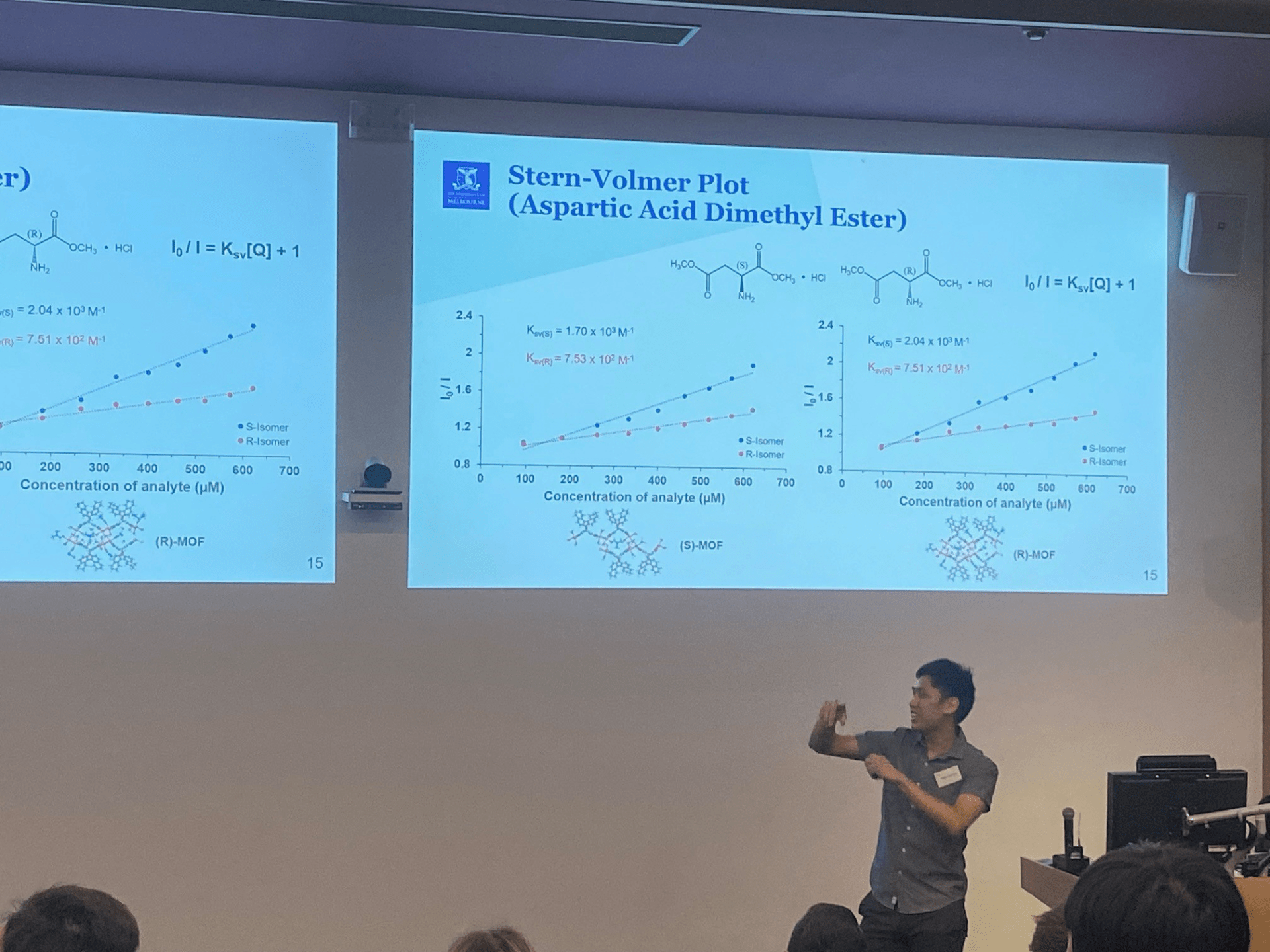
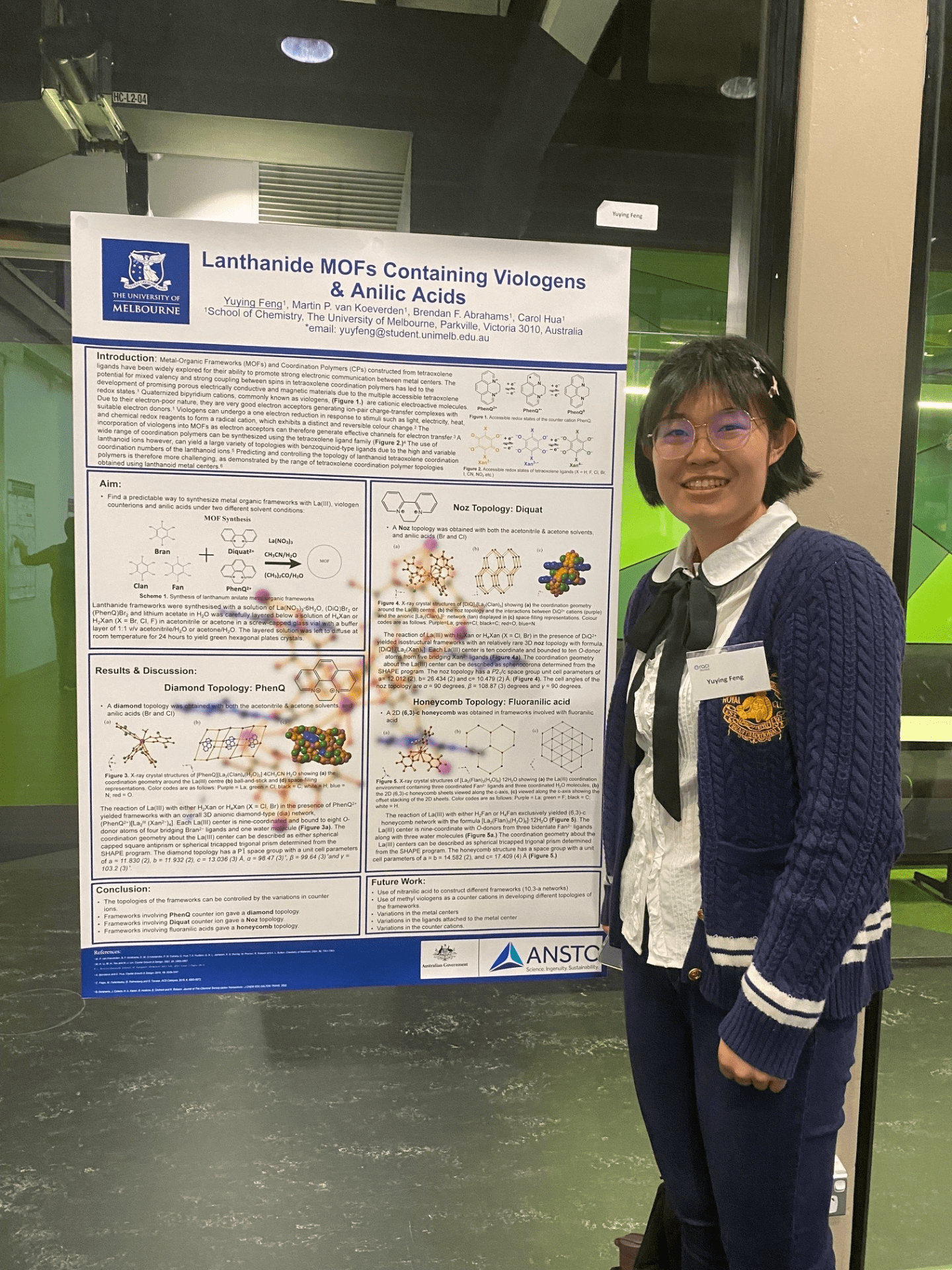
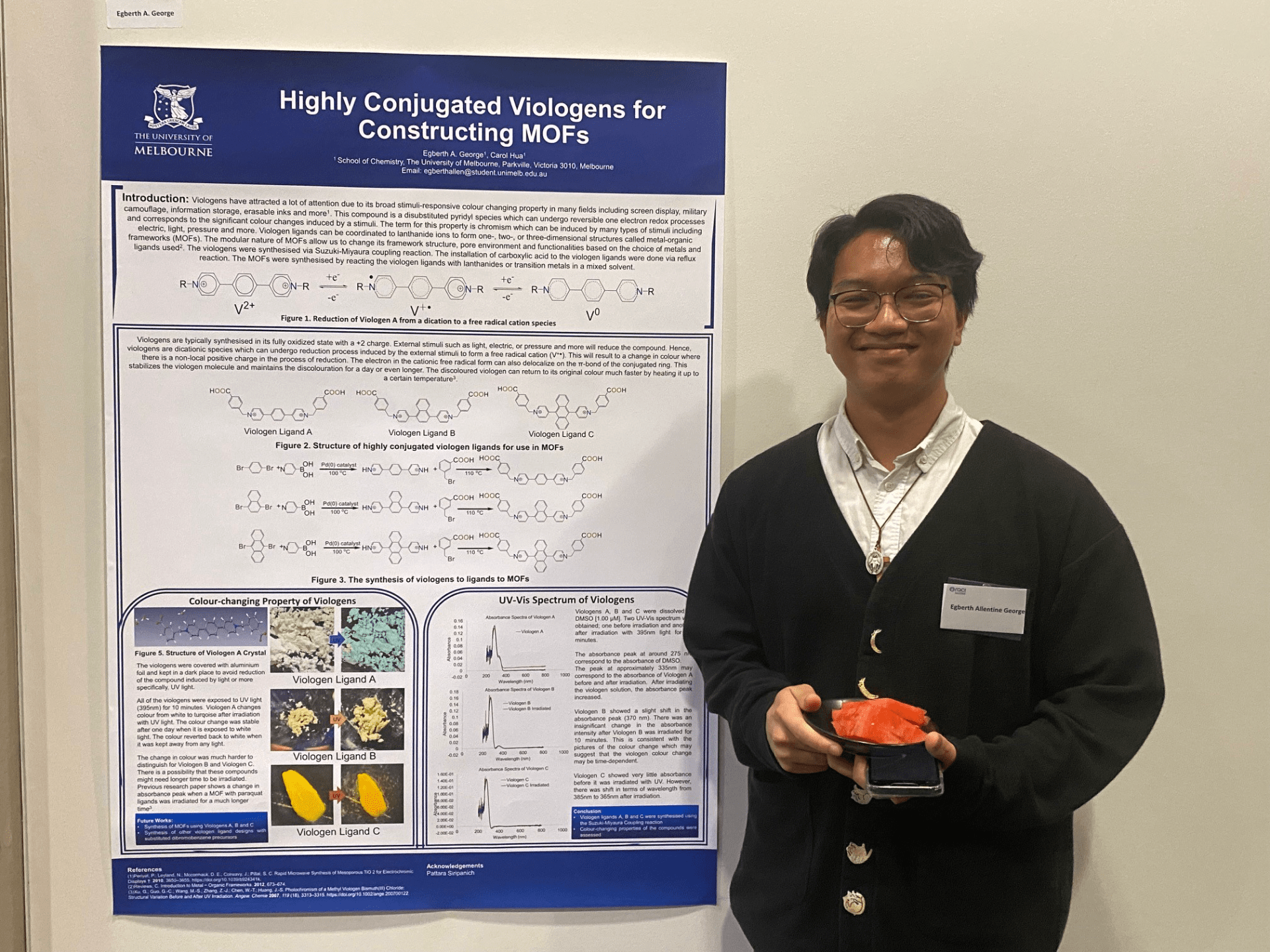

Pat presenting at Supramol24 (UNSW, Sydney) and ACCC9 (Bangkok, Thailand)
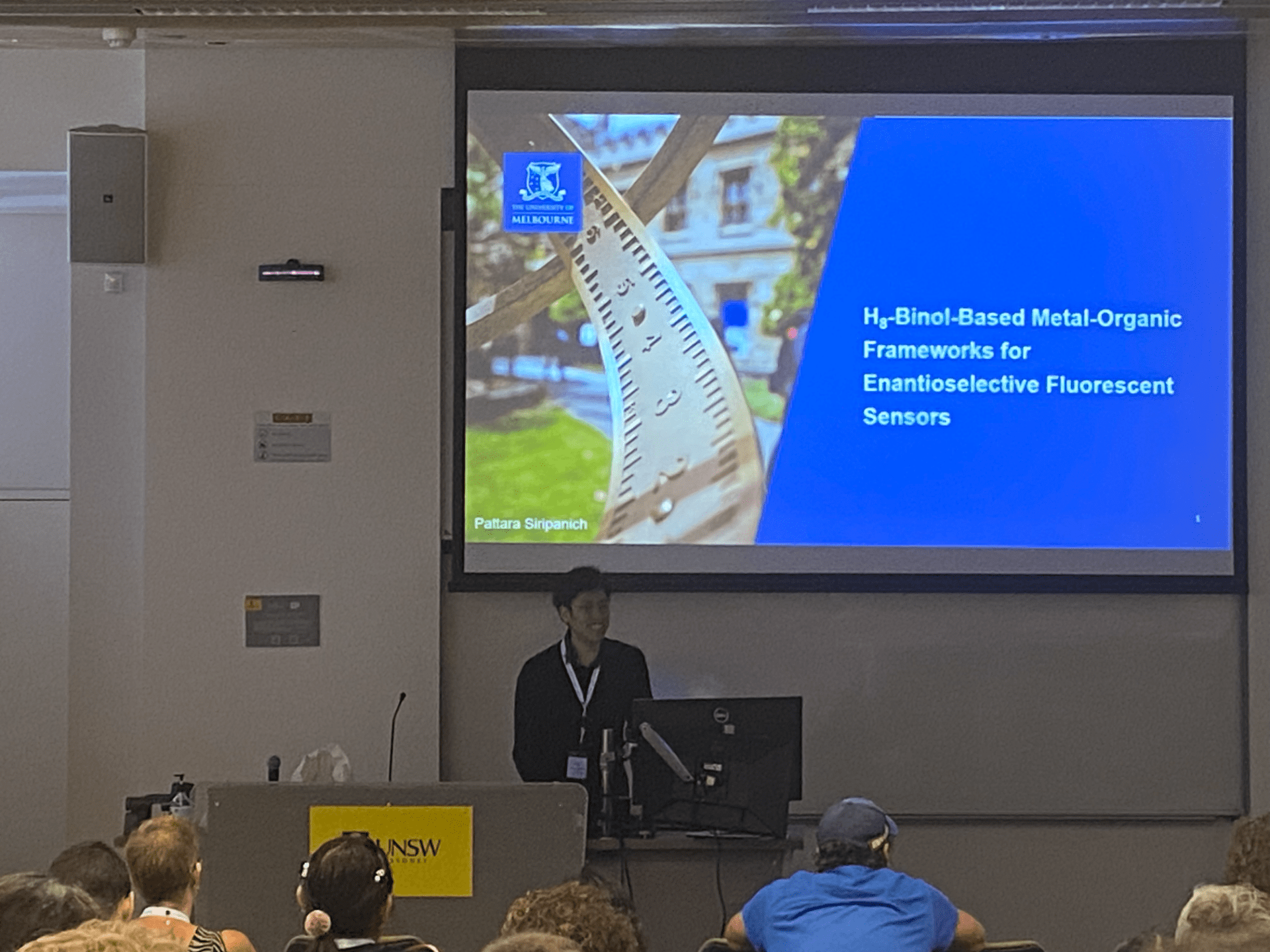

Group Photos
